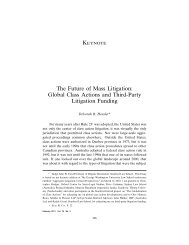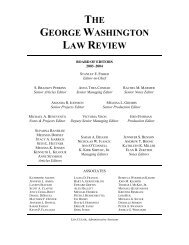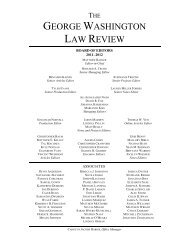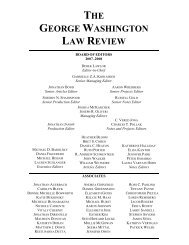View PDF - The George Washington Law Review
View PDF - The George Washington Law Review
View PDF - The George Washington Law Review
Create successful ePaper yourself
Turn your PDF publications into a flip-book with our unique Google optimized e-Paper software.
876 <strong>The</strong> <strong>George</strong> <strong>Washington</strong> <strong>Law</strong> <strong>Review</strong> [Vol. 78:870<br />
ernmental action. 26 Despite the fact that the Court in Penn Central<br />
merely identified “factors that have particular significance,” 27 the<br />
Court cited these exact factors a year later in Kaiser Aetna v. United<br />
States. 28 <strong>The</strong>se factors have come to be known as the Penn Central<br />
three-factor test. 29<br />
<strong>The</strong>reafter, however, the Court recognized a pair of per se rules<br />
that, in the author’s view, created doubt about the appropriate analysis<br />
for regulatory takings claims. In Loretto v. Teleprompter Manhattan<br />
CATV Corp., 30 the Court held that a taking occurs if the regulation<br />
causes a permanent physical occupation. 31 Subsequently, the Court<br />
established a second per se rule for regulatory takings in Lucas v.<br />
South Carolina Coastal Council, 32 holding that a taking occurs if the<br />
regulation denies the owner all economically viable use of the land. 33<br />
It was arguable that the per se rules were meant to replace Penn<br />
Central as the sole source of regulatory takings analysis. 34 A significant<br />
amount of evidence indicated that the Court had indeed abandoned<br />
ad hoc balancing in favor of bright-line rules. First, the<br />
language in Penn Central stating that diminution in property value<br />
alone cannot establish a taking 35 cannot be reconciled with the holding<br />
of Lucas, 36 which states that a complete economic wipeout constitutes<br />
a per se taking. 37 Second, Justice Scalia, the Court’s chief proponent<br />
of bright-line rules, authored the majority opinion in Lucas, and to<br />
26 Penn Cent., 438 U.S. at 124.<br />
27 Id.<br />
28 Kaiser Aetna v. United States, 444 U.S. 164, 174 (1979).<br />
29 See Peterson, supra note 2, at 1317.<br />
30 Loretto v. Teleprompter Manhattan CATV Corp., 458 U.S. 419 (1982).<br />
31 See id. at 426 (holding that the mandatory installation of cable facilities on a property<br />
constituted a regulatory taking because the government intrusion was a permanent physical<br />
occupation).<br />
32 Lucas v. S.C. Coastal Council, 505 U.S. 1003, 1015 (1992).<br />
33 See id. (holding that a per se taking occurs “where regulation denies all economically<br />
beneficial or productive use of the land”).<br />
34 See John D. Echeverria, Making Sense of Penn Central, 23 UCLA J. ENVTL. L. & POL’Y<br />
171, 172–73 (2005) (noting that “the Court appeared poised to jettison the Penn Central analysis<br />
altogether. During the 1980’s and 1990’s, as an antidote to the chronic vagueness of the Penn<br />
Central framework, the Court attempted to develop a set of alternative, bright line tests”).<br />
35 See Penn Cent. Transp. Co. v. New York City, 438 U.S. 104, 131 (1978) (recognizing that<br />
past decisions “uniformly reject the proposition that diminution in property value, standing<br />
alone, can establish a ‘taking’”).<br />
36 See Echeverria, supra note 25, at 5 (questioning how Penn Central’s insistence that no<br />
diminution in property value is sufficient to establish a taking can be reconciled with Lucas’s<br />
bright-line rule that a taking occurs “where regulation denies all economically beneficial or productive<br />
use of land”).<br />
37 See Lucas, 505 U.S. at 1019.









